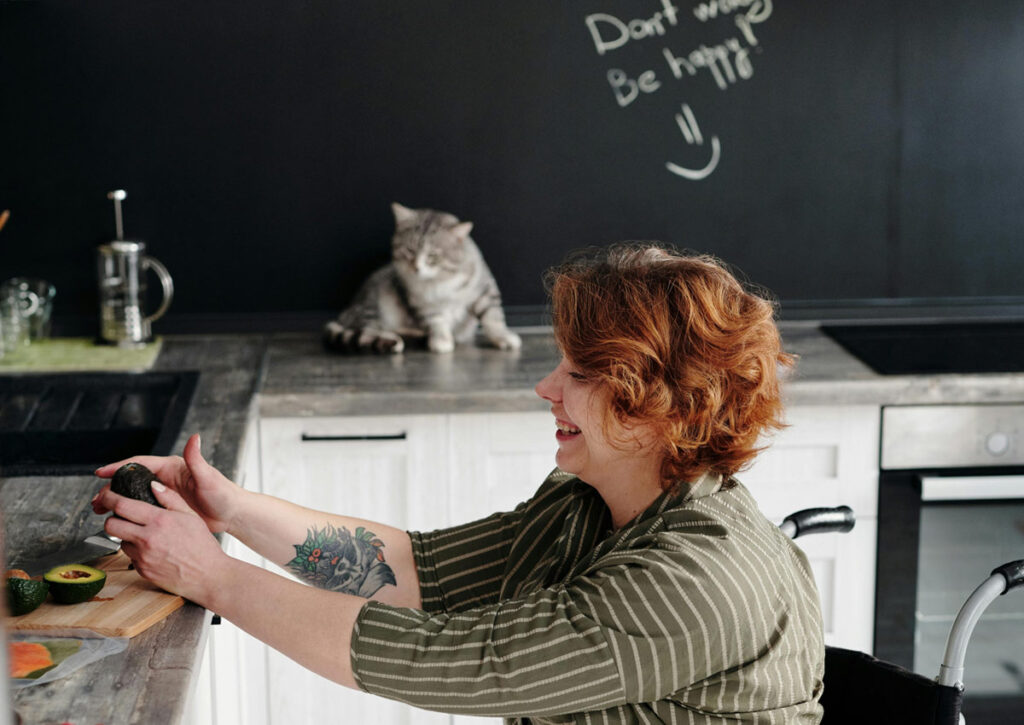As we get older, the thought of aging becomes more personal and real. Many of us start to reflect on what it would mean to live out our golden years comfortably and with dignity. For 80-90% of people, this means staying in their homes, surrounded by the things they love and cherish. The desire to maintain independence, savor memories, and stay close to family and friends drives this decision. However, making a home a safe space where you can age comfortably takes planning, foresight, and in some cases, a little remodeling.

Why Aging in Place Matters
Independence and Familiarity
At the heart of aging in place is the desire to maintain control over one’s life. When people grow older, moving to an assisted living facility or nursing home may seem like a loss of independence. Many seniors describe this transition as feeling “warehoused,” where their individual needs and comforts are secondary to the routine of the institution.
This scenario hits home for me. A close family member had to move into a care facility after a sudden fall. Their home wasn’t set up to accommodate their new mobility needs, and it was a tough adjustment—emotionally and physically. For most, the idea of leaving a home filled with memories and moving into a care facility is heart-wrenching. Staying at home in a familiar environment, on the other hand, offers not only comfort but also better mental health, especially for those dealing with memory issues. Studies show that people who remain in a familiar place do better cognitively and emotionally.

Connection to Community and Loved Ones
Staying at home means staying connected to the community you’ve invested in over the years. Whether it’s attending church, volunteering, or simply knowing the neighbors, social connectedness is vital for a healthy life. It gives seniors a reason to get up in the morning, fostering a sense of purpose. The ability to remain near family and friends keeps that support network close, helping to combat loneliness and depression.
When planning for aging in place, location matters. If you’re still in the earlier stages of planning, think about your proximity to important resources. Are you close to public transportation, grocery stores, or senior centers? If you can walk to a bus stop or a local shop, that level of autonomy can extend your ability to live independently longer.

The Challenges of Aging in Place
Planning Before the Crunch Time
One of the most common mistakes people make is waiting until they’re forced to make changes. I’ve seen homeowners scrambling to make adjustments after a sudden injury or illness. This reactionary approach often leads to rushed decisions and incomplete solutions. By planning early, you can prepare your home for the future while you’re still able to oversee the changes.
For example, learning to use technology, such as a smartphone or an IoT (Internet of Things) system, before any memory issues develop can make the transition smoother. These devices can track your location via GPS, monitor your appliances, and control lights, all while enhancing safety and socialization. It’s also wise to prepare financially—whether by saving or exploring home modification grants—to ensure you have the resources when the time comes.
Financial Considerations
As life expectancy increases, so do financial concerns. Many retirees are living longer than expected and may not have saved enough for extended care. Social security and pensions remain static, while the cost of living continues to rise. This reality makes it essential to plan for potential health declines or the need for home modifications.
Whether you’re planning for a major remodel or just small upgrades, it’s important to assess both the short- and long-term financial implications. Nonprofits and community programs sometimes offer assistance for home repairs and energy efficiency upgrades. For instance, in some areas, the health department may replace an outdated wood stove, or local programs may provide help with weatherization and repairs.

How to Make Your Home Safer
Fall Prevention
Falls are one of the greatest risks for seniors. One in three Americans over 65 falls each year, and 20% of those falls result in serious injuries. Modifying your home to prevent falls should be a top priority when planning to age in place.
Start with simple modifications:
- Install grab bars in bathrooms, near toilets, and in showers.
- Add railings on both sides of stairs.
- Remove rugs and floor mats that could pose a tripping hazard.
- Adjust the height of beds and furniture to make them easier to use.
- Consider smart light switches and motion sensor lighting to avoid fumbling in the dark.
For intermediate changes, you may want to install stair lifts, replace steps with ramps, or make your bathroom more accessible by switching to a walk-in shower. In the long term, you might remodel your kitchen and bathroom for ease of use. For instance, large-format, anti-slip tiles in the bathroom or a curbless shower can prevent slips and falls.
Addressing the Most Important Rooms
The first room to consider for modification is the bathroom. It’s often the smallest space in the house but poses the most danger. Small changes like installing a shower wand, adding grab bars, or even widening the doorway for wheelchair access can make all the difference. Think about the toilet height—choosing an extra tall toilet can make it easier to sit and stand without strain.
Next, focus on access to your home. Stairs leading from your car to the front door can be a significant barrier. If possible, replace stairs with a sloping sidewalk, eliminate any unnecessary screen doors, and make sure the door threshold is as level as possible to avoid tripping. Lastly, consider your kitchen. Make sure there’s enough space to move comfortably, and if possible, lower countertops and install front-facing knobs on your stove to reduce the need for bending or reaching.

Incorporating Technology for Safety and Convenience
One of the most exciting advancements in aging in place is the rise of affordable technology. Home monitoring systems, GPS tracking, and IoT devices can make life easier and safer. You can install kinetic or wireless doorbells that don’t require electricity or batteries. These can be placed in key locations, such as near the bed, in the bathroom, or even in a pocket, and signal for help if needed.
Additionally, smart home systems can allow you to control lights, appliances, and security features from a smartphone or tablet. These small touches can provide peace of mind for both you and your family.
The Importance of Building a Support Team
As much as technology helps, nothing can replace a good support system. Surrounding yourself with friends, family, neighbors, and a community of volunteers is essential for emotional well-being. Aging in place doesn’t mean you have to do it all alone—reach out to those around you and build a network that can step in when needed.
Whether it’s attending social events, joining a local church, or simply staying active in your community, keeping a vibrant social life will enhance your quality of life as you age. It’s not just about safety—it’s about thriving.

Conclusion: The Right Time and Place to Stay at Home
There’s no denying that aging presents challenges, but with the right preparation and mindset, staying in your home can be a fulfilling, independent, and safe experience. Start early with small, manageable changes and build toward long-term solutions. Surround yourself with people who care, invest in technology that keeps you safe, and enjoy the familiarity of a home filled with memories.
Aging in place isn’t just about staying put—it’s about continuing to live a full, connected, and independent life in the place that matters most.
The Long-Term Benefits of Aging in Place
Choosing to age in place offers a wide range of long-term benefits, both for your physical well-being and your emotional health. By staying in your home, you maintain a sense of control and independence, which can significantly boost your self-esteem and overall happiness. Home modifications, like installing grab bars or converting your bathroom to a walk-in shower, not only increase safety but also enhance the comfort of your daily routine.
Remaining in a familiar environment can help improve memory and cognitive function, especially for those dealing with dementia or Alzheimer’s. You also preserve your social connections by staying close to friends, family, and your local community, which is essential for maintaining emotional health. Aging in place allows you to stay active, whether through volunteering, participating in neighborhood events, or simply enjoying your favorite activities in the comfort of your own home.
Financially, investing in home improvements for aging in place can save you money in the long run by delaying or even eliminating the need for expensive assisted living facilities. With thoughtful planning, you can ensure that your golden years are spent in a place that supports your lifestyle, health, and happiness.




0 Comments